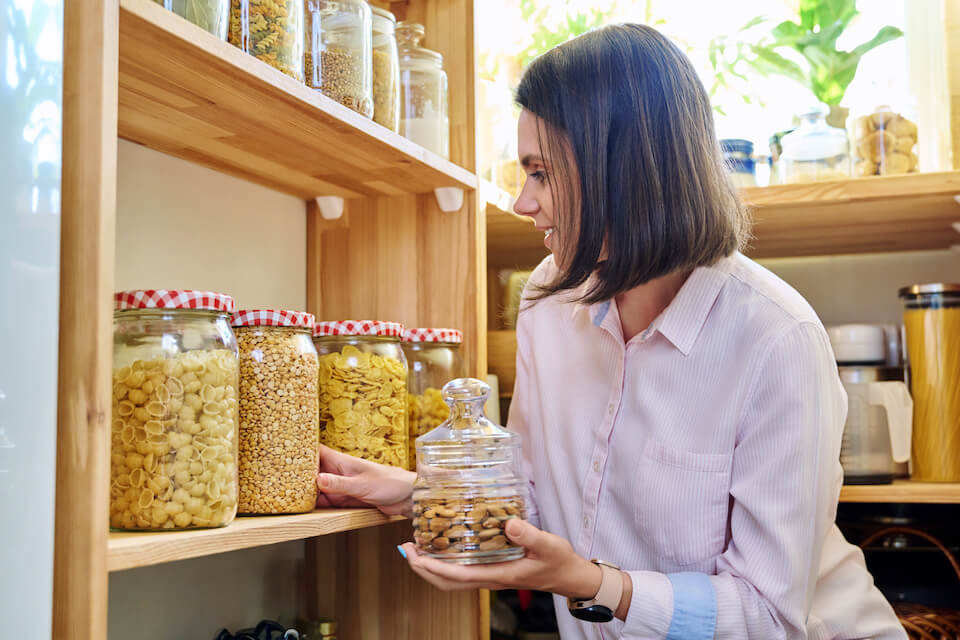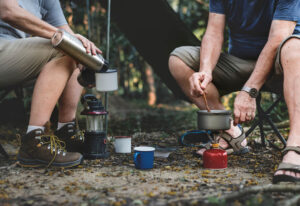
You know those little inedible packets you find at the bottom of snack bags like beef jerky, and even at the bottom of shoe boxes? Those are oxygen absorbers, also called oxygen scavengers. While some of your favorite food brands use them in their packaging, you can also use them at home to help store your emergency food. Learn what oxygen absorbers do and how you can use them in your emergency food storage techniques.
How Do Oxygen Absorbers Work?
Oxygen absorbers are little packets filled with iron powder and salt. They help decrease the amount of oxygen in a package and are used to extend food shelf life. The packets are made of material that allows oxygen to enter but prevents the iron powder from leaking out. The iron inside will react with any available oxygen in the air or food, causing it to rust. As the iron rusts, it absorbs oxygen and can reduce oxygen in the package to below 0.1%. In addition to extending shelf life, oxygen absorbers also help prevent food damage from insects and stop the growth of mold, mildew, and bacteria.
How Long Do Oxygen Absorbers Last?
Oxygen absorbers start to work as soon as they are exposed to oxygen. According to Utah State University, oxygen absorbers still in their original package will last around six months to a year. Once you open a package, you should use oxygen absorbers within 15 minutes and store any leftovers in an airtight container for up to six months.
When you place an oxygen absorber in your food packaging, it will absorb all the oxygen and stop the oxidation process until exposed to oxygen again. They will continue to work until they are completely spent, which is when they will turn brown and clumpy.
What Foods Can You Use Oxygen Absorbers With?
Oxygen absorbers should be used with foods that are low in oil and have a moisture content below 10%. Some common foods you can use oxygen absorbers with are:
- Dried meats like jerky
- Flour
- White rice
- Potato flakes
- Pasta
- Spices
- Dehydrated fruits and vegetables
- Pet food
Foods Not to Use Oxygen Absorbers With
Not every food can or should be stored with oxygen absorbers. This includes:
- Foods that are high in moisture. Never use oxygen absorbers with foods containing 35% or more moisture. Reducing the oxygen in the packaging of these foods can lead to botulism poisoning. Stick to foods with 10% or less moisture content. You can usually contact the food manufacturer to get details about moisture levels.
- Foods high in oil. Food items like nuts and seeds contain a lot of oil. They will have a shorter shelf life and turn rancid faster than low-oil foods.
- Foods that aren’t sensitive to oxygen. Oxygen absorbers won’t harm these foods, but they won’t help them either. Your oxygen absorbers would be wasted on wheat, beans, corn, and peas.
- Foods that will clump. Removing oxygen from ingredients like salt and sugar will cause them to clump and harden, ruining them altogether.
How to Use Oxygen Absorbers for Food Storage
Oxygen absorbers are easy to use, but you need to make sure you have the right supplies on hand and follow correct procedures.
1. Select the Proper Containers
The first thing you need to do is find good, airtight containers for storing your food. Some of the best containers for the job are Mylar bags, metal cans, PETE plastic bottles, plastic buckets (lined with Mylar bags), and canning jars.
2. Make Sure You Have the Correct Size and Number of Absorbers
With your container picked out, you need to make sure you have enough oxygen absorber packets ready to go. Packets come in sizes from 20cc (cubic centimeters) to 2500cc. The cubic centimeters are related to how much oxygen the packet can absorb. The bigger a container is, the more oxygen the packets will need to absorb. Keep in mind that foods like rice will take up more space in a container and have less oxygen, while something like pasta will leave more room for air.
On average, a quart container will need a 50cc absorber, a gallon or #10 cans will need 300cc, and a 5 gallon will need about 1500cc. Having too many oxygen absorbers won’t harm your food, so you can always throw a few extra in if you aren’t sure you have enough.
3. Set Out Your Supplies
Once you’ve determined your container and the number of absorbers you’ll need, it’s time to set up your workspace. Remember, you only have about 15 minutes to use oxygen absorbers after taking them out of the package. You want to be able to move fast and efficiently. If you’re using jars or buckets, have them set out with the lids off and next to them. If you’re using Mylar bags, make sure they’re open. Have your unopened bag of oxygen absorbers within reach.
4. Fill Your Containers with Food
With clean hands or gloves, fill your containers with the food you want to store. A funnel or scoop can help prevent spilling.
5. Add the Oxygen Absorbers and Seal the Containers
Move fast to drop the necessary number of oxygen absorbers into your containers, trying your best to stick that 15 minutes. Seal each container immediately after. If you have a partner, one of you can drop the absorbers in while the other follows quickly behind to seal the containers.
6. Store Any Remaining Absorbers
If you have leftover absorbers, it’s crucial you store them correctly. Place them in an airtight jar or use an iron to reseal their original package. Use within 6 months.
7. Store Your Containers
Follow emergency food storage best practices. Find a cool, dark place to store the container, and keep the container at least six inches off the ground. Try to keep heavier items at the bottom and work your way up so the lightest items are at the top. Finally, keep good records so you know where everything is and how much you have.
Play it Safe with Emergency Food from 4Patriots
Worried about packaging your own survival food? Take the guesswork out of the equation with 4Patriots. Our survival food kits are packed in “disaster-resistant” Mylar®* that help protect against air, light and moisture. You can enjoy a shelf life of up to 25 years with proper storage!** Shop our long-term emergency food kits online today.
*Mylar® brand is a registered trademark of Dupont Tejjin Films. Dupont is not affiliated with and has not endorsed or sponsored this product.
**Your survival food is designed to last 25 years on the shelf. Storage conditions impact the shelf life of your food. For best results, always protect your food from heat, air and moisture. Avoid prolonged exposure to temps above 75 degrees F. Keep food sealed until ready to eat. Shelf life will vary based on storage conditions.

